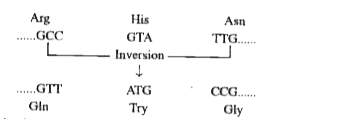Explain in detail about the types of gene mutations.Solution in Punjabi
Types of Mechanism of Gene Mutations. The smallest part of a gene that can undergo mutation is known as muton. It can be as small as a single nucleotide. Most of the gene mutations involve a change in only a single nucleotide. A gene may undergo several point mutations. This produces multiple alleles. Gene mutations occur by three methods-inversion, substitution (of two types-transition and transversion) and frameshift (of two types-insertion and deletion).
1. Inversion. A distortion of DNA by mutagen can change the base sequence of a cistron in the reverse order. The process is called inversion. The new sequence will naturally have different codons,. e.g.,

2. Substitution (Replacement). In substitution a nitrogen base is changed with another. It is of two types, transition and transversion. (i) Transition. A nitrogen base is replaced by another of its type, that is, one purine is replaced by another purine (adenine guanine) while one pyrimidine by another pyrimidine (cytosine = thymine or uracil). e.g.,

(ii) Transversion. In this a purine base is substituted or replaced by pyrinidine base and vice versa. e.g., Cytosine with Guanine (C⇔ G) Adenine with thymine (A⇔ T)

3. Frame-Shift. It is gene mutation where the reading of codons is changed. due to insertion or deletion of nucleotides. It is just like changing the sentence-The Fat Dog Ate the cat by insertion of alaphabet T. It will read-The Tfa Tdo cat Eth Eca T which is meaningless. Similarly, deletion of letter F will produce another meaningless sentence-The Atd oga Tet Hec At. Insertion of one or more nucleotides shifts the reading of nucleotide frame in the forward direction while deletion will cause a backward reading of frame. (i) Insertion. One or more nuleotides are added in the DNA segment representing a gene.

(ii) Delection. One or more nucleotides are lost from a segment of DNA representing a cistron or gene.

Nonsense, Same-sense and Mis-sense Mutations. A nonsense mutation is the one which stops polypeptide synthesis due to formation of a terminating or nonsense codon, viz., ATT(UAA), ATC(UAG), ACT(UGA). A mis-sense mutation is the one which involves change in a codon that produces a-different arnino acid at the specific site in polypeptide, often resulting in its nonfunctioning. A same-sense mutation is silent mutation in which the codon is changed but the change does not alter the amino acid specificity (e.g., GCA→GCT or GCC or GCG).
Topper's Solved these Questions
- BOOK - BETTER CHOICE PUBLICATIONCHAPTER - PRINCIPLES OF INHERITANCE AND VARIATION EXERCISE - SHORT ANSWER TYPE QUESTIONS66videos
PRINCIPLES OF INHERITANCE AND VARIATION
- BOOK - BETTER CHOICE PUBLICATIONCHAPTER - PRINCIPLES AND PROCESSES IN BIOTECHNOLOGY EXERCISE - LONG ANSWER TYPE QUESTIONS16videos
PRINCIPLES AND PROCESSES IN BIOTECHNOLOGY
- BOOK - BETTER CHOICE PUBLICATIONCHAPTER - REPRODUCTION IN ORGANISMSEXERCISE - LONG ANSWER TYPE QUESTIONS (5 MARKS)11videos
REPRODUCTION IN ORGANISMS
Similar Questions
Who is responsible for the sex of the new born child. Male or Female? Explain.
02:10View SolutionWhat is recombinant DNA technology? Explain in brief the various steps in the process of recombinant DNA technology.
04:18View SolutionExplain various artificialmethods of vegetative propagation.
01:56View Solutionजीन म्यूटेशन क्या है ? जीन म्यूटेशन के क्या कारण है ? समझाइए ।
01:36View SolutionMention the types of gene or point mutation.
03:06View Solutionइन में से प्रत्येक में जीन उत्परिर्तन (Gene mutation) के प्रकार को समझाइए-
ATGCATGC -ACGCATGC02:47View Solutionइन में से प्रत्येक में जीन उत्परिर्तन (Gene mutation) के प्रकार को समझाइए-
ATGCATGC -ATGAATGC03:49View Solutionजीन उत्परिवर्तन को परिभाषित कीजिए।
04:01View Solutionजीन म्यूटेशन की विशेषताएँ क्या हैं? समझाइए।
03:14View SolutionMention the types of Cymose inflorescence. (or) Explain in detail about the types of cymose inflorescence.
01:32View Solution(b) Explain in detail about various types of direct gene transfer method.
03:40View SolutionExplain in detail about various types of extinctions.
04:01View Solution(b) Explain in detail about heterosis and its types.
02:34View SolutionTransition type of gene mutation is caused when .............
03:01View Solution(b) Explain in detail about various types of direct gene transfer method.
56:54View SolutionWhat is mutation? Explain the two types of mutation.
51:18View Solution

